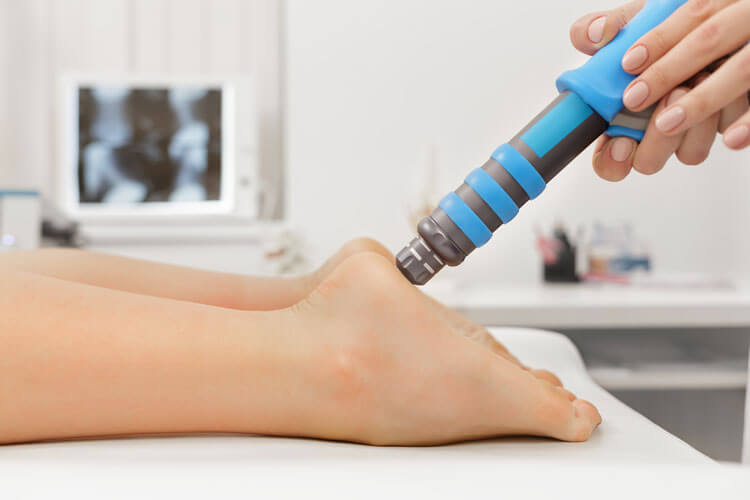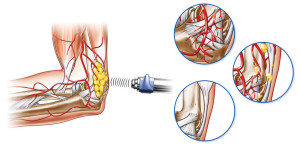Sometimes long-lasting pain limits your ability to complete daily tasks, the impact that persistent pain can have on your physical and emotional well-being. Nowadays advancements in medical technology have led to the development of innovative treatments like Radial Shockwave Therapy that can provide relief and promote healing.
Table of Contents
What is Radial Shockwave Therapy?
It is a non-invasive treatment that operates high-energy radial pressure wave to stimulate the body’s natural healing process. These waves are generated by a device and are sent to the affected area through a handheld applicator. The action is commonly used to address musculoskeletal conditions, including continuing pain, tendonitis, plantar fasciitis, and shoulder impingement syndrome.
How Does Radial Shockwave Therapy Work?
Unlike traditional therapies that focus solely on managing pain symptoms, it aims to target the root cause of the problem. The high-energy sound waves create microtrauma within the affected tissues, which triggers the body’s healing response. This response includes increased blood flow, the development of new blood vessels, and the release of growth aspects that promote tissue regeneration. In simpler terms, it’s like jump-starting your body’s natural healing process.

The Benefits of Radial Shockwave Therapy
- Non-Invasive: One of the utmost advantages is that it is a non-invasive treatment. This means that it does not need surgical cuts or anesthesia.
- Pain Relief: It provides effective pain relief by reducing swelling, stimulating tissue restoration, and promoting the release of pain-relieving substances in the body.
- Improved Function: By stimulating tissue regeneration, improves the overall function of the affected area.
- Minimal Side Effects: Compared to more aggressive treatments, the side effects negligible. Some patients may experience mild discomfort during treatment, but this usually diminishes quickly.
- Quick Recovery: Since this treatment does not involve surgery or lengthy recovery periods, patients can resume their daily activities shortly after each session.
Conditions Treated with Radial Shockwave Therapy
Radial shockwave therapy has shown promising results in the treatment of various musculoskeletal conditions. Here are some of the conditions that can benefit from this innovative therapy:
1. Chronic Pain
Do you suffer from chronic pain that seems to have no end? Radial shockwave therapy offers hope for individuals dealing with long-lasting pain. By targeting the source of the pain and promoting tissue regeneration, this therapy can provide lasting relief and improve your quality of life.
2. Tendonitis
Tendonitis arises when a tendon becomes inflamed. It commonly affects the tendons in the shoulders, wrists, elbows, ankles, and knees. This treatment can help reduce inflammation and stimulate healing, allowing individuals with tendonitis to regain strength and mobility.
3. Plantar Fasciitis
Plantar fasciitis is a common condition that causes heel pain and inflammation. It can make walking and standing unbearable. It can effectively address plantar fasciitis by targeting the affected area, reducing pain, and promoting healing.
4. Shoulder Impingement Syndrome
If you’ve ever experienced pain or discomfort in your shoulder when lifting your arm or performing certain movements, you may be dealing with shoulder impingement syndrome.
5. Myofascial Trigger Points
Myofascial trigger points are tight knots or nodules in the muscles that can cause localized pain and discomfort. Shockwave therapy can be used to treat these trigger points, helping to relax the muscles and alleviate pain.
The Radial Shockwave Therapy Procedure
The procedure typically involves several sessions, depending on the severity and nature of the condition being treated. During each session, the physician will apply the handheld applicator to the affected area and deliver the sound waves. The duration and intensity of the treatment will vary based on the individual’s needs. Most patients experience a gradual reduction in pain and improvement in function throughout the treatment process.

Is Radial Shockwave Therapy Right for You?
If you are experiencing chronic pain or have been diagnosed with a musculoskeletal condition that could benefit from tissue regeneration and pain relief. Consult with a qualified Physiotherapist who specializes in this therapy to determine if it is suitable for your specific condition.
Conclusion
By stimulating the body’s natural healing response, this non-invasive treatment delivers long-lasting relief and enhanced function for individuals suffering from various musculoskeletal conditions. Don’t let chronic pain hold you back any longer. Explore the transformative effects of radial shockwave therapy and take the first step towards a pain-free and active life.
Frequently Asked Questions (FAQs)
Q1: How many sessions of radial shockwave therapy are typically required?
A1: The number of sessions required varies depending on the individual and the specific condition being treated. In general, several sessions spread over a few weeks are recommended for optimal results.
Q2: Is radial shockwave therapy painful?
A2: Most patients experience mild discomfort during the treatment, but it is generally well-tolerated. The intensity can be adjusted to ensure the patient’s comfort.
Q3: Are there any side effects associated with this treatment?
A3: The side effects are minimal. Some patients may experience mild redness, bruising, or temporary increase in pain after the treatment, but these usually subside quickly.
Q4: Is radial shockwave therapy covered by insurance?
A4: Insurance coverage varies depending on the insurance provider and the specific plan. It is advisable to check with your insurance company to determine coverage eligibility.
Q5: How long does it take to see results?
A5: Some patients experience immediate relief after the first session, while others may require a few weeks to see noticeable improvement. Results may vary depending on the individual and the nature of the condition being treated.
Q6: Can radial shockwave therapy be combined with other treatments?
A6: Yes, it can be used in conjunction with other treatments such as physical therapy and medication to enhance the overall outcome.
Q7: Is there any downtime associated with radial shockwave therapy?
A7: No, there is typically no downtime associated. Patients can resume their daily activities immediately after each session.
Q8: Can radial shockwave therapy treat sports injuries?
A8: Yes, it is often used in the treatment of sports injuries. It can help accelerate healing, reduce pain, and restore function to injured tissues.
Q9: How long has radial shockwave therapy been used as a treatment?
A9: It has been utilized as a treatment option for over two decades and has gained recognition for its effectiveness in managing various musculoskeletal conditions.
Q10: Where can I find reputable radial shockwave therapy clinics in London, Ontario, Canada?
A10: Quantam physiotherapy is a private physical therapy clinic centrally located in London Ontario easily accessible from all corners and around the city.
Click Here to Book an Appointment of Professional & Experienced Physiotherapists
Also Read: Worst Sports Injuries: Best Practices for Optimal Recovery

